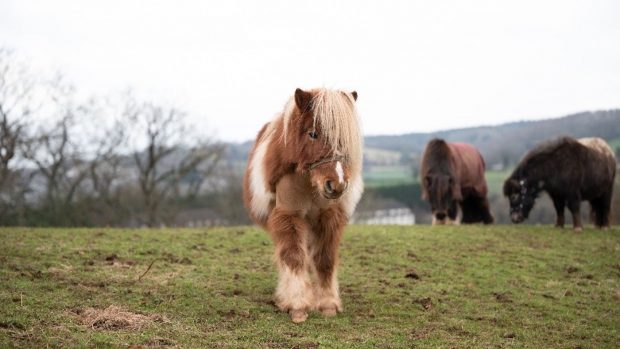The Shetland pony is a small, hardy breed of horse from the Shetland Isles, off Scotland’s north-east coast.
Shetland pony: history | common uses | breed type | health problems
Small horses have existed in Shetland for more than 2,000 years, with archaeological excavations on the islands revealing bones of Bronze age equids. Horses probably crossed onto the Shetlands from the icefields and were later crossed with stock brought by Norse settlers.
The breed was further influenced by the Celtic pony, brought to the islands between 2000 and 1000 BC. Because of their isolation, the Shetland pony developed without much influence from more modern breeds, and they were notable for the hardiness and longevity. Quality feed was hard to come by on the islands, and the winters were long and harsh. Only the toughest and most resourceful ponies survived. Shetlanders used the ponies for transport and for pulling carts and carrying peat and coal around the islands.
The ponies arrived in mainland Britain during the mid-19th century. During the industrial revolution, the need for coal increased dramatically, and in 1847, a law was passed that banned women and children from being used to haul coal out of the pits. Miners turned to Shetland ponies, and thousands were imported to the mainland to be pit ponies. They are strong for their size — a Shetland can haul twice its weight, while a draught horse can haul half its weight at most — and small enough to pass through low underground tunnels. Some were even transported to the eastern United States to work as pit ponies there. The animals spent most of their lives underground and often did not live very long.
Up to the end of the 19th century, the ponies were living semi-feral on the Sheltand Isles and simply rounded up, but around 1880, studs appeared in the islands, the best known of which was owned by the Marquis of Londonderry and operated on the islands of Noss and Bressay. The Shetland Pony Studbook Society was formed in 1890 to maintain the quality and purity of the breed, as so many were being exported to the coal mines.
Popular uses of Shetland ponies today
Today, many ponies still live fairly free range lives on the Shetland Isles, grazing on rough moorland known as ‘scattald’, or common grazing. They are also popular everywhere else, as children’s mounts or working in harness or as pets and companions, as they are relatively cheap to keep. However, just because they are small does not mean they require any less time or effort than their larger equine cousins.
There is also a popular Shetland Pony Grand National series, where children ride the ponies over a track of small steeplechase jumps. The series raises finds for charity and takes place at major shows around the country, with the final being held at the London International Horse Show in December.

In the United States, some miniature Shetlands are being used as guide horses for the blind, while one guide horse has been trained in the UK.
Shetland pony breed type
The ponies must be small and hardy, standing at no more than 42 inches. Their minimum height is 28 inches. They have heavy coats, short legs, and a wide, dished face with small, alert ears. Their backs are broad and strong, and they have dense manes and tails. They are generally brave and good-tempered, although they have a reputation for being opinionated and intelligent — sometimes more intelligent than their owners, which can make them a challenging first pony.
Irvine Burgess, who breeds ponies on the Shetland Isles says: “All ponies have their own individual personality, some are lazy and some are fiery. Shetland ponies sometimes have a reputation for being cheeky and sometimes a bit stroppy, but the truth is they are an intelligent breed capable of figuring out how to escape and how to take advantage of a situation.
“It’s like having a bright child — they will soon take advantage of you, given half a chance, so it’s important to set boundaries, give them structure and be consistent with what you teach them particularly when they are young.”
Common health problems
Shetland ponies are long-lived, easily reaching 30 and not suffering many health problems. However, like any tough moorland breed, they are at risk of laminitis if their diet isn’t carefully managed. Due to their small size, they can also be more prone to heart problems than larger horses.
You might also be interested in:

Cobs: everything you need to know about this versatile type
Here's everything you need to know about cobs

Subscribe to Horse & Hound this spring for great savings
For all the latest equestrian news and reports, don’t miss Horse & Hound magazine out every Thursday





